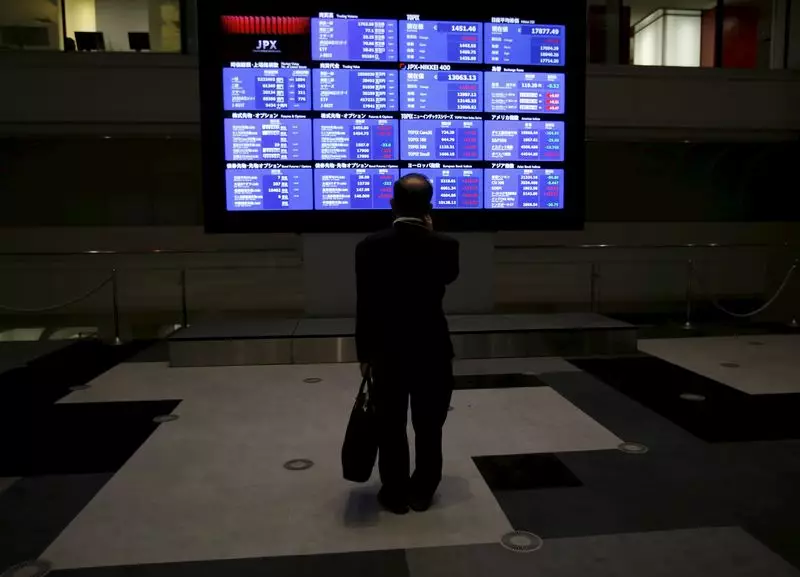The Asian stock market is navigating a clouded landscape marked by uncertainty and thin trading volume, particularly due to the ongoing holidays in various regions. Early trading on Monday revealed that investors were hesitant, primarily due to incomplete details surrounding the Chinese government’s pledged economic stimulus. This lack of clarity poses a challenge for investors trying to establish the parameters of China’s financial support measures, which has led to increased caution in the market. The influential statements made by Finance Minister Lan Foan regarding a “significant” increase in debt were met with skepticism; investors are left pondering the exact magnitude of the stimulus—an essential element necessary to understand the prospects for a sustained market rally.
Investor sentiment took a hit following a weekend where expectations for an explicit fiscal announcement from Chinese authorities were not met. Markets were primed for a definitive monetary response, anticipating further detailed plans that could bolster economic recovery following the initial boost in response to aggressive stimulus measures announced last month. Ray Attrill, head of FX strategy at National Australia Bank, voiced a collective concern about market reactions. His observations highlight a critical issue: uncertainty over the extent of fiscal loosening and the potential lack of direct support for consumers is likely to keep investors on edge.
Despite the MSCI Asia-Pacific index posting a minor gain of 0.12% on Monday morning, the trading environment remains fragile. The index experienced a decline of 1.7% in the preceding week, illustrating the volatility that presently characterizes this sector. With Japan closed for holidays, the overall activity was muted, and futures in the U.S. further reflected downward trends in anticipation of market reactions to the lack of clarity emerging from China’s economic strategies.
Adding to the challenging economic landscape, recent inflation data from China paints a picture of an economy struggling with deflationary pressures. September’s consumer inflation dropped unexpectedly while producer price deflation intensified, signifying a weak economic recovery. This situation raises the stakes for the Chinese government to act decisively with further stimulus, especially after last month’s initiatives appeared to lose momentum. In response to this data, analysts from Goldman Sachs raised their 2023 GDP growth forecast for China from 4.7% to 4.9%, alongside caution about long-term growth challenges. Their insights pinpoint the underlying issues facing China’s economy, often referred to as the “3D” challenges: declining demographics, prolonged debt deleveraging trends, and shifts in global supply chains.
The offshore yuan and Australian dollar reflected market sentiment early Monday. The yuan experienced a slight decrease, dropping 0.2% against the dollar, while the Australian dollar, often viewed as a proxy for the yuan, followed suit with a 0.15% dip. Currency movements underscore the broader apprehension surrounding China’s economic trajectory and how it may ripple across global markets. Meanwhile, in the currency realm, the U.S. dollar remains robust, buoyed by perceptions that the Federal Reserve will maintain a steady course on interest rates in the near term, notwithstanding fluctuations in consumer price indices.
In light of these developments, other currencies such as the British pound and euro experienced minor declines against the dollar, further indicating a world bracing for potential shifts in economic policy and market responses.
In the commodities market, declining sentiment around growth prospects led to significant drops in oil prices. Brent crude saw a decrease of over $1 per barrel, correlating with fears surrounding demand linked to the unclear economic direction from China. As market players react to the modest inflation data and ambiguous stimulus announcements, Brent crude futures fell by approximately 1.39%, a sentiment echoed in the West Texas Intermediate benchmarks. Precious metals too reflected subdued trading trends, with gold easing slightly as investors reassess their strategies amidst a backdrop of uncertainty.
As Asian markets remain in a state of uncertainty, the balance between investor optimism regarding stimulus measures and the worrying signs of economic struggle, particularly in China, will play a crucial role in determining future trends. The success of any supportive measures and their reception in the market will need to be closely monitored, as will ongoing inflation data from global markets, shaping the investment landscape in the coming weeks.

